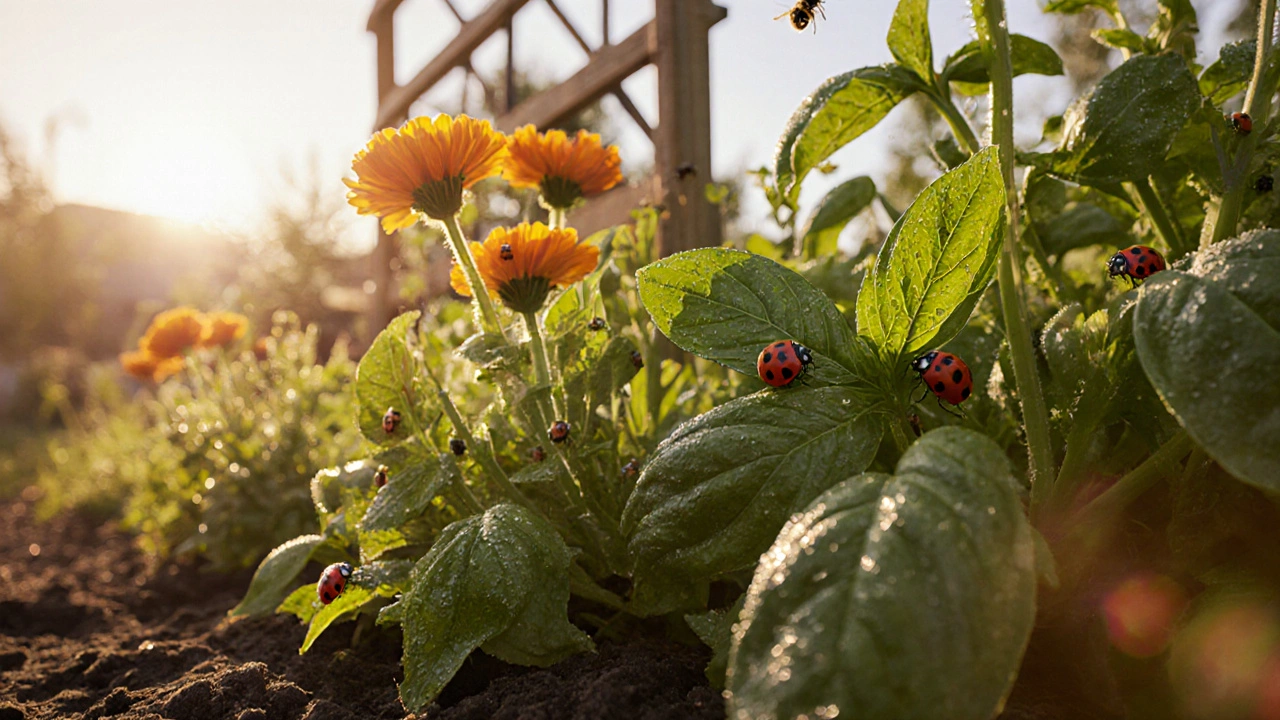Natural Pest Control Made Easy for Indian Gardens
Want to keep bugs away without chemicals? You can do it with a few smart choices and kitchen leftovers. Natural pest control works best when you understand what pests like and what plants hate them.
Companion Planting Basics
Pairing the right plants can turn your garden into a pest‑free zone. For example, marigold releases compounds that repel nematodes and aphids, so planting a border of marigolds around tomatoes can cut down damage. Basil next to peppers scares off spider mites, and mint under cucumbers keeps beetles at bay. These “sister plants” don’t just look good; they create a protective shield that reduces the need for sprays.
When you plan a raised bed, think about stacking layers of defense. Start with a base of hardy herbs like rosemary and thyme, then add leaf‑loving veggies in the middle, and finish with flowers that attract beneficial insects on the edges. Ladybugs love the pollen from dill and fennel, and they will hunt down aphids for you.
Home‑Made Remedies You Can Mix Today
Kitchen scraps are treasure chests for pest control. Coffee grounds, for instance, are great for acid‑loving plants like blueberries, but many leafy greens and roses actually dislike them. Spread a thin layer of used grounds around plants that you want to protect from slugs and ants – the gritty texture and caffeine act as a barrier.
Neem oil is another garden staple. Mix a teaspoon of cold‑pressed neem oil with a cup of water and a few drops of mild soap, then spray on leaves every seven to ten days. The oil interferes with insects’ feeding and breeding cycles, yet it’s safe for humans and most beneficial insects when used correctly.
If you prefer a spray that smells fresh, blend garlic cloves, chili peppers, and a splash of soap in water. Let it sit overnight, strain, and spray on foliage. The strong scent deters caterpillars, beetles, and even some fungal issues.
Don’t forget good cultural practices. Watering early in the day lets leaves dry before night, cutting down fungal spores. Mulching with straw or dry leaves keeps the soil moist and reduces weed growth, which in turn lowers hiding spots for pests.
Finally, keep an eye on the soil. Healthy soil hosts beneficial microbes that outcompete harmful organisms. Adding compost, cow dung, or vermicompost feeds these microbes, improving plant vigor and natural resistance.
Natural pest control isn’t a magic bullet, but combining companion planting, kitchen‑based sprays, and solid garden hygiene can dramatically cut down pest pressure. Try one method at a time, watch the results, and adjust as needed. Your garden will stay greener, safer, and more productive without a chemical cocktail.
DIY Natural Pest Control: Simple Home Remedies for a Bug‑Free Garden
Learn practical DIY natural pest control methods-from garlic spray to diatomaceous earth-plus recipes, safety tips, a comparison table and a handy checklist for a healthier garden.
Alternative Pest Control: Natural Solutions for Safe Gardening
Explore smart, safe alternatives to chemical pesticides for your garden. Learn how natural, organic, and sustainable solutions can keep pests in check.
Natural Aromas That Repel Bugs: What Scents Keep Pests Away?
Discover the natural scents that bugs despise most and learn how to use these aromas to keep pests away from your living space. This guide explores the science behind why certain smells are effective at repelling insects, shares practical tips for utilizing these scents at home, and delves into unconventional yet effective natural solutions for bug control. Whether you're dealing with mosquitoes, flies, ants, or other common pests, find out how to make your surroundings inhospitable to these unwanted guests without resorting to chemicals.
About
Pest Control
Latest Posts


Best Season for Flowers in India: Unveiling the Blooms
By Alden Thorne Feb 17, 2025

How Many Acres of Rice Are Needed to Feed One Person?
By Alden Thorne Oct 28, 2025

Most Sustainable Plant in the World: A Real Game-Changer for Your Garden
By Alden Thorne Apr 23, 2025



